Freshwater aquarium sharks are a group of fish species that have similar physical features to actual sharks, such as their dorsal fins, sleek bodies, and pointed heads. They are not actual sharks, but they are popular among aquarium hobbyists due to their unique and fascinating appearance. They can add an interesting dynamic to a freshwater aquarium and provide an exciting and exotic addition to the tank.
There are several species of freshwater aquarium sharks available in the pet trade, including the Bala Shark, Rainbow Shark, Red Tail Shark, Silver Shark, and Black Shark. Each species has unique physical features and behaviors that make them desirable for different types of aquarium setups.
Importance Of Proper Care For Freshwater Aquarium Sharks:
Proper care and maintenance are essential for the health and well-being of freshwater aquarium sharks. They require specific tank parameters, including water quality, temperature, and filtration, to thrive in a captive environment. It’s important to research and understand the specific needs of each species of shark before adding them to an aquarium. Providing appropriate tankmates and a suitable diet is also essential for their overall health and happiness. By providing proper care, freshwater aquarium sharks can live long and healthy lives in a captive environment.
Disclosure: This article contains affiliate links. When you follow a link to purchase the products, I sometimes earn a commission, at no additional cost to you. Read my full disclosure here.
Types of Freshwater Aquarium Sharks
- Bala Shark
The Bala Shark, also known as the Silver Shark, is a popular freshwater aquarium shark due to its unique appearance and peaceful nature. They can grow up to 14 inches long and require a large aquarium with plenty of swimming space. They are omnivorous and require a varied diet of both plant and animal-based foods.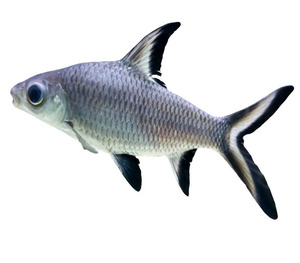
- Rainbow Shark
The Rainbow Shark, also known as the Red Fin Shark, is a territorial fish that requires plenty of hiding spots and caves in their aquarium. They can grow up to 6 inches in length and are known for their vibrant red fins. They are omnivorous and require a varied diet of both plant and animal-based foods.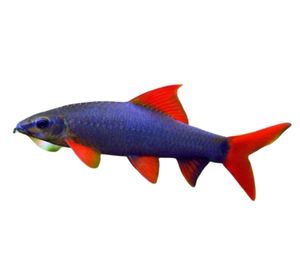
- Red Tail Shark
The Red Tail Shark, also known as the Red Tail Black Shark, is a popular freshwater aquarium shark due to its striking black body and vibrant red tail. They are territorial fish and require plenty of hiding spots and caves in their aquarium. They can grow up to 6 inches in length and are omnivorous, requiring a varied diet of both plant and animal-based foods.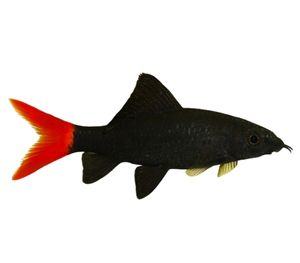
- Silver Shark
The Silver Shark, also known as the Bala Shark, is a peaceful freshwater aquarium shark that requires a large aquarium with plenty of swimming space. They can grow up to 14 inches long and are omnivorous, requiring a varied diet of both plant and animal-based foods.
- Black Shark
The Black Shark, also known as the Black Shark Minnow, is a peaceful freshwater aquarium shark that requires plenty of swimming space and hiding spots in their aquarium. They can grow up to 6 inches in length and are omnivorous, requiring a varied diet of both plant and animal-based foods. They are known for their striking black body and red fins.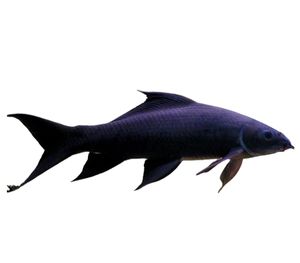
Tank Setup for Freshwater Aquarium Sharks
- Aquarium Size Requirements
Freshwater aquarium sharks require a large tank with plenty of swimming space. The minimum tank size for most species of freshwater aquarium sharks is 55 gallons, but larger tanks are recommended for larger species. It’s essential to consider the adult size of the shark species when choosing an aquarium size.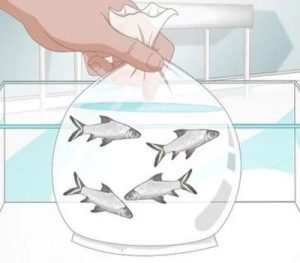
- Water Parameters And Quality
Freshwater aquarium sharks require specific water parameters and quality to thrive in a captive environment. The ideal water temperature for most species is between 72-82°F, and the pH should be between 6.5-7.5. It’s also important to monitor ammonia, nitrite, and nitrate levels regularly and perform regular water changes to maintain proper water quality.
- Aquascaping And Decorations
Freshwater aquarium sharks require plenty of hiding spots and caves in their aquarium. Aquascaping with rocks, driftwood, and live plants can provide hiding spots and make the aquarium more aesthetically pleasing. It’s important to choose decorations that won’t harm the sharks, as some species are known to dig and move objects in the tank.
- Filtration And Water Flow
Adequate filtration and water flow are essential for maintaining proper water quality in a freshwater aquarium shark tank. A canister filter or a power filter rated for a larger aquarium is recommended. It’s also important to provide water flow to mimic the natural environment of the sharks, as some species prefer a strong current.
- Lighting Requirements
Freshwater aquarium sharks don’t have specific lighting requirements, but it’s essential to provide a suitable photoperiod. Most aquariums require 8-10 hours of light per day, but it’s important to monitor algae growth and adjust lighting as needed. It’s also important to choose aquarium lighting that won’t harm the sharks or promote excessive algae growth.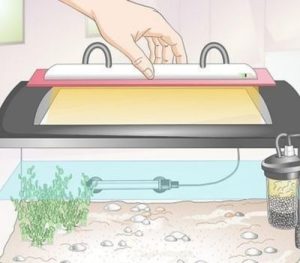
Feeding & Nutrition of Freshwater Aquarium Sharks
Freshwater aquarium sharks are carnivorous and require a diet high in protein. In the wild, they feed on small fish, insects, crustaceans, and other aquatic organisms. In a captive environment, it’s important to provide a varied diet to ensure they receive all the necessary nutrients.
Besides that, the feeding frequency and quantity depend on the species, age, and size of the shark. In general, adult freshwater aquarium sharks should be fed once or twice a day, while younger or smaller sharks may require more frequent feedings. Overfeeding should be avoided as it can lead to health issues and water quality problems. There are several types of food that provide a balanced diet for freshwater aquarium sharks, including:

- Pellets: High-quality pellets designed specifically for carnivorous fish can be used as a staple diet. Pellets are convenient and provide all the necessary nutrients.
- Frozen or live food: Frozen or live food such as bloodworms, brine shrimp, and krill can be used as a treat or to supplement the pellet diet.
- Fresh seafood: Fresh seafood such as shrimp, squid, and fish can also be used to supplement the pellet diet. It’s important to avoid feeding raw fish as it may contain harmful bacteria.
- Vegetables: Some species of freshwater aquarium sharks may also benefit from a small number of vegetables such as zucchini or cucumber to supplement their diet.
Maintenance of Freshwater Aquarium Sharks
Maintenance of freshwater aquarium sharks involves regular tasks to ensure their health and well-being, as well as maintaining the quality of their environment. Here are some essential maintenance tasks:
- Regular water changes: Regular water changes are essential for maintaining the quality of the shark’s environment. The frequency and amount of water change depends on the tank size, stocking level, and filtration system. As a general rule, a 10-20% water change every 1-2 weeks is recommended.
- Cleaning the filter: The filter is responsible for removing waste and maintaining water quality in the aquarium. It’s important to clean or replace the filter media regularly to ensure optimal performance.
- Cleaning the aquarium: Regular cleaning of the aquarium glass and decor can help maintain a healthy environment for the sharks. Algae growth should be removed, and uneaten food and waste should be siphoned out.
- Monitoring water parameters: Water parameters such as ammonia, nitrite, nitrate, pH, and temperature should be monitored regularly to ensure the water quality is within the recommended range. Any significant changes should be addressed immediately to prevent health issues.
- Checking equipment: Regular checks of the equipment, including the heater, filter, and air pump, can help ensure they are functioning correctly. Any faulty equipment should be replaced or repaired promptly.
- Observing the sharks: Observing the sharks daily can help identify any health issues or abnormal behavior. Signs of stress or illness, such as lethargy or loss of appetite, should be addressed immediately to prevent further complications.
Conclusion
All in all, it can be said that choosing tank mates with aquarium sharks can be one of the most crucial decisions that you’d have to make if you plan on getting them. This is because not all fish are compatible with freshwater aquarium sharks. Some species may be aggressive, while others may not tolerate the high flow rates required by sharks. Therefore, it’s essential to choose tank mates that are compatible with your shark’s temperament and behavior. Also, sharks can become stressed if they are constantly chased or intimidated by other fish in the tank. This can lead to health issues and even death. By choosing compatible and peaceful tank mates, you can help promote a healthy and stress-free environment for your sharks.



